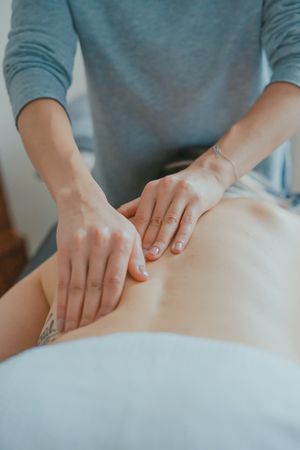Thoracic Back Pain
Original Editor - Lucinda hampton
Top Contributors - Nupur Smit Shah, Lucinda hampton, Kim Jackson and Aminat Abolade
Introduction[edit | edit source]
Thoracic back pain is common throughout life but is not as well studied as neck pain or low back pain. Thoracic back pain is more often due to serious spinal pathology than neck or low back pain but thoracic back pain is also prevalent among healthy individuals without any serious underlying cause.[1]
Epidemiology[edit | edit source]
The range of prevalence estimates of thoracic back pain in the general population is broad because of many factors eg the different definitions and duration of thoracic back pain included.
Prevalence data ranged from
- 4.0-72.0% (at any one time)
- 0.5-51.4% (seven-day)
- 1.4-34.8% (one-month)
- 4.8-7.0% (three-month)
- 3.5-34.8% (one-year)
- 15.6-19.5% (lifetime).
Higher prevalence for thoracic back pain in children and adolescents, females > males.
Aetiology[edit | edit source]
| Children | Adults | ||
|---|---|---|---|
| Weight of back pack | Concurrent other musculoskeletal symptoms which includes poor posture. | ||
| Postural changes associated with backpack use.
Musculoskeletal symptoms, participation in specific sports, |
Difficulty in performing activities of daily living. | ||
| Chair height at school | Lower grade male white-collar workers were more likely to report TSP (17%) than male workers in other occupational categories
Upper grade female white-collar and professional workers were more likely to report TSP[2]. |
Thoracic back pain occurs
- As a result of trauma or sudden injury
- Through strain or poor posture over time
- From inflammatory, degenerative, metabolic, infective and neoplastic condition.
- From conditions such as primary and secondary osteoporosis (especially vertebral fractures and hyperkyphosis arising from vertebral bone loss), ankylosing spondylitis, osteoarthritis and Scheuermann's disease
The most common cause of thoracic back pain appears to originate from
- Muscular irritation
- Lack of strength,
- Poor posture,
- Prolonged sitting at a computer,
- Using a backpack,
- Overuse injuries (such as repetitive motion), or
- Trauma (such as a whiplash injury caused by a car accident or as a result of a sports injury).
- Trigger points
Asymptomatic thoracic disc herniations are relatively common but symptomatic disc herniations are rare. They occur in approximately 5 in 1,000 disc herniations presenting in a clinical setting.[1]
Thoracic spine pain can be complex issue. The thoracic spine is compromised of 12 vertebrae and this part of the spine joins with the ribs to make the costovertebral joints. This part of the spine is often injured as a result of poor postural habits and structures which can cause pain include joints, muscles, ligaments, nerves and discs.
Red flags has to be ruled out on the patients having thoracic back pain.
Mechanism Of Injury[edit | edit source]
Thoracic pain can occur by following mechanisms:
Compression fracture
Burst Fracture
Direct Blow[3]
Muscle Fatigue
Muscle tendon connective tissue strain or sprain
Changes in the tendon/ tissue mechanical properties[4]
Vertebral osteomyelitis
Clinical Presentation[edit | edit source]
Thoracic pain / tenderness usually occurs at C7-T1 and T12- L1.It is frequently and not completely associated with pathologies like osteoporosis, osteoarthritis, ankylosing spondylitis and Scheurmann's disease.
Examination[edit | edit source]
Thoracic examination is often overlooked and complex. It should be assessed as a functional unit of spine and rib cage.
Outcome Measures[edit | edit source]
Roland‐Morris Disability Questionnaire
Fear avoidance belief's questionnaire
Quebec Back Pain Disability Scale
Differential Diagnosis[edit | edit source]
Vertebral osteomyelitis
Peri myocarditis
Potts diease (Tuberculosis of spine)
Thoracic disc herniation with acute myelopathy
Multidisciplinary Team Management[edit | edit source]
Multidisciplinary rehabilitation is an effective way to treat back pain. The multidisciplinary team usually includes a physiotherapist, psychologist , sports teacher and a physician. It includes :1.5 hours of restorative exercise therapy, 0.5 hours of progressive muscle relaxation,0.5 hours of physical therapy,0.5 hours of patient education and one hour of cognitive behavioral therapy.[5]
Physiotherapy Management[edit | edit source]
Physiotherapists are university trained in the assessment and treatment of spinal problems. Early and acute treatment focuses on understanding the diagnosis, reduction in pain and poor movement patterns and restoration of range of motion.
Physiotherapists treat thoracic spine pain using a variety of techniques including:
- Soft tissue massage, muscular and trigger point releases
- Light thoracic spinal mobilisations for pain relief
- Firm thoracic spinal mobilisations for stiffness
- Manipulations
- Modalities such as heat, ice and TENs
- Protection such as compression, padding, strapping
- Support braces or tape assisted posture retraining
- Muscular stretches
- Range of motion and breathing exercises
- Postural training for core and alignment
- Muscular strength and endurance exercises
- Dry Needling
- Patient education and ergonomic advice is a must for making changes in the lifestyle.
- Patient should be encouraged to pursue a hobby or sports activities.
References[edit | edit source]
- ↑ 1.0 1.1 Briggs AM, Smith AJ, Straker LM, Bragge P. Thoracic spine pain in the general population: prevalence, incidence and associated factors in children, adolescents and adults. A systematic review. BMC Musculoskeletal disorders. 2009 Dec;10(1):77. Available from:https://www.ncbi.nlm.nih.gov/pubmed/19563667?dopt=Abstract (last accessed 24.4.2020)
- ↑ Fouquet N, Bodin J, Descatha A, Petit A, Ramond A, Ha C, Roquelaure Y. Prevalence of thoracic spine pain in a surveillance network. Occupational Medicine. 2015 Mar 1;65(2):122-5. Available from:https://academic.oup.com/occmed/article/65/2/122/1488588 (last accessed 24.4.2020)
- ↑ Hanley EN, Eskay ML. Thoracic spine fractures. Orthopedics. 1989 May 1;12(5):689-96.
- ↑ Richmond J. Multi-factorial causative model for back pain management; relating causative factors and mechanisms to injury presentations and designing time-and cost effective treatment thereof. Medical hypotheses. 2012 Aug 1;79(2):232-40.
- ↑ Lang E, Liebig K, Kastner S, Neundörfer B, Heuschmann P. Multidisciplinary rehabilitation versus usual care for chronic low back pain in the community: effects on quality of life. The Spine Journal. 2003 Jul 1;3(4):270-6.









